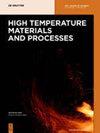石墨坩埚与Fe-Si-B相变材料相互作用的中试实验
IF 1.5
4区 材料科学
Q4 MATERIALS SCIENCE, MULTIDISCIPLINARY
引用次数: 0
摘要
摘要Fe-26Si-9B合金具有熔合热高、体积变化小、丰度高、成本低等优点,是一种很有前途的高温相变材料。此外,石墨已被确定为该合金的容器材料的有前途的候选者。在本研究中,在中试规模上研究了石墨用于Fe-26Si-9B HTPCM的可行性。具体来说,4-5 kg的Fe-26Si-9B母合金在感应炉的石墨坩埚中熔化,在1100 - 1375°C的温度范围内进行了2-3次热循环。结果表明:合金中有SiC和b4c析出;然而,这些碳化物只存在于凝固合金的表面,而不存在于主体中。然而,Fe-26Si-9B合金的化学成分在热循环过程中保持相对稳定。实验还发现,石墨坩埚经受住了温度循环而没有开裂。因此,使用石墨作为Fe-26Si-9B相变材料的容器是一种很有前途的方法。本文章由计算机程序翻译,如有差异,请以英文原文为准。
Graphite crucible interaction with Fe–Si–B phase change material in pilot-scale experiments
Abstract Fe–26Si–9B alloy is a promising high temperature phase change material (HTPCM), due to its high heat of fusion, small volumetric change, abundance, and low cost. Additionally, graphite has been identified as a promising candidate for use as a container material for this alloy. In this study, the feasibility of using graphite for Fe–26Si–9B HTPCM is investigated in a pilot-scale. Specifically, 4–5 kg Fe–26Si–9B master alloys were melted in graphite crucibles using an induction furnace, which underwent 2–3 thermal cycles in the temperature range of 1,100–1,375°C. The results showed that SiC and B 4 C precipitates were formed in the alloys. However, these carbides were found to be present only on the surface of the solidified alloys and not in the main body. Still, the chemical composition of the Fe–26Si–9B alloy remained relatively stable during the thermal cycles. It was also seen that the graphite crucible withstood the temperature cycles without cracking. Therefore, the use of graphite as a container for Fe–26Si–9B phase change material is a promising approach.
求助全文
通过发布文献求助,成功后即可免费获取论文全文。
去求助
来源期刊

High Temperature Materials and Processes
工程技术-材料科学:综合
CiteScore
2.50
自引率
0.00%
发文量
42
审稿时长
3.9 months
期刊介绍:
High Temperature Materials and Processes offers an international publication forum for new ideas, insights and results related to high-temperature materials and processes in science and technology. The journal publishes original research papers and short communications addressing topics at the forefront of high-temperature materials research including processing of various materials at high temperatures. Occasionally, reviews of a specific topic are included. The journal also publishes special issues featuring ongoing research programs as well as symposia of high-temperature materials and processes, and other related research activities.
Emphasis is placed on the multi-disciplinary nature of high-temperature materials and processes for various materials in a variety of states. Such a nature of the journal will help readers who wish to become acquainted with related subjects by obtaining information of various aspects of high-temperature materials research. The increasing spread of information on these subjects will also help to shed light on relevant topics of high-temperature materials and processes outside of readers’ own core specialties.
 求助内容:
求助内容: 应助结果提醒方式:
应助结果提醒方式:


